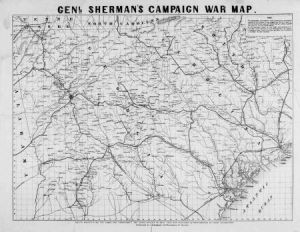 One day after departing from Atlanta proper on the March to the Sea, the army of U.S. General William T. Sherman destroys the railroad track to the north of Stone Mountain (the city having been effectively destroyed by the Federals in July).
One day after departing from Atlanta proper on the March to the Sea, the army of U.S. General William T. Sherman destroys the railroad track to the north of Stone Mountain (the city having been effectively destroyed by the Federals in July).
White citizens had fled when the Union army approached the day before. When Sherman encamped last night, slaves, their masters having left the city, gathered around his army. Today, they follow when the Federals break camp and continue eastward.
Thus begins the liberation of many thousands of slaves during Sherman’s March to the Sea, many (likely most) of whom are Baptists. The neighborhood in which Sherman camped in Stone Mountain comes to be known as Shermantown, in celebration of the general’s liberation of the city’s blacks.
The March to the Sea is the latest chapter in a much larger march for freedom in the South that has already liberated more than a hundred thousand slaves. Sherman faces little opposition in the weeks ahead, even as the remaining white resistance to freedom crumbles before Union military might.
Source: Barry L. Brown and Gordon R. Elwell, Crossroads of Conflict: A Guide to Civil War Sites in Georgia, Athens, Ga.: University of Georgia Press, 2010 (link)


